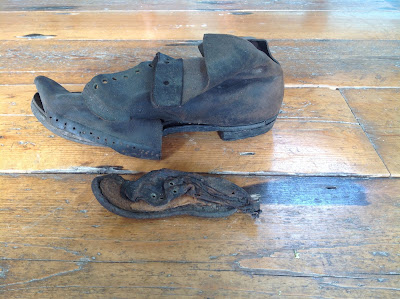600-a site specific art installation by Jenny Wood-Sullivan
600 is a site-specific installation by artist Jenny Wood-Sullivan. The title references the quantity of paupers which could be housed in Portumna workhouse.
The use of a number as the installation title immediately
highlights Jenny's interest in how paupers were processed in the workhouse
system, essentially reducing people to just numbers on a page. With this in
mind, it is striking how visually pleasing and gentle the installation appears,
with the contemplative art of origami (a Japanese technique of folding
paper into a variety of forms) taking centre stage.
As the visitor walks
through one of the original workhouse rooms, they are witness to a flock of 600
origami birds flying down towards the floor, in a desperate attempt to reach a
solitary seed. The viewer does not need to be told that there is not enough
food for all. The birds themselves are folded from the pages of an old tome
titled The Church and Science by Sir Bertram C. A.
Windle, printed in 1917. What could be a more fitting contrast to
the ephemeral lives of these birds than the twin institutional mights of church
and science? This relationship is heightened when we consider that this book
was actually in print during the workhouse era.
As
you walk around the trapped and fragile flock, it is easy to feel that you are
in the presence of 600 pauper souls, as if the simple act of folding paper has
magically summoned them from the past. This feeling is re-enforced by the
perimeter of the room. Jenny set up home-made pinhole cameras in various points throughout the workhouse
complex and the resulting images were then used as backdrops for found and
original imagery such as dormitory beds. The result is an eerie,
supernatural version of a photograph. It is as if a tourist has taken a snap on
their tour of the workhouse and somehow the past has bled through
into the modern photograph.
The idea of trying to summon images from the past into the
present is echoed in the time-lapse footage which plays on a loop in one corner
of the room. The distorted snippets of crow caws and human syllables only
re-iterates that what we see of the past is fragmented and simplified. We can
never get the whole picture. Even the simple, delicate nature of the projection
screen begs the viewer to wonder; is this a vision of history that will
disappear at any moment?
Another aspect of Jenny's art is a nod to the fairy-tale. Tiny women populate twig nests which are barren, showing how women in the workhouse system worked for naught. Precarious towers of turf look prone to collapse as they support tiny houses of paper. A house appears to fly through the air in one of the hanging images. All around the room is a sense of something strange and eerie, but above all, fragile. It looks as if a sudden gust could tear all asunder. What better way to understand poverty than to see that it renders your life totally precarious?
It is wonderful to see 600 address workhouse history with
such delicacy, poignancy and originality. The sadness and loss experienced by
the inmates of Irish workhouses is explored slowly and subtly, and one can't
help feeling that they are grateful to finally be shown the compassion and care
that they had to do without when they were alive.
By Elizabeth Carter
By Elizabeth Carter






Comments
Post a Comment